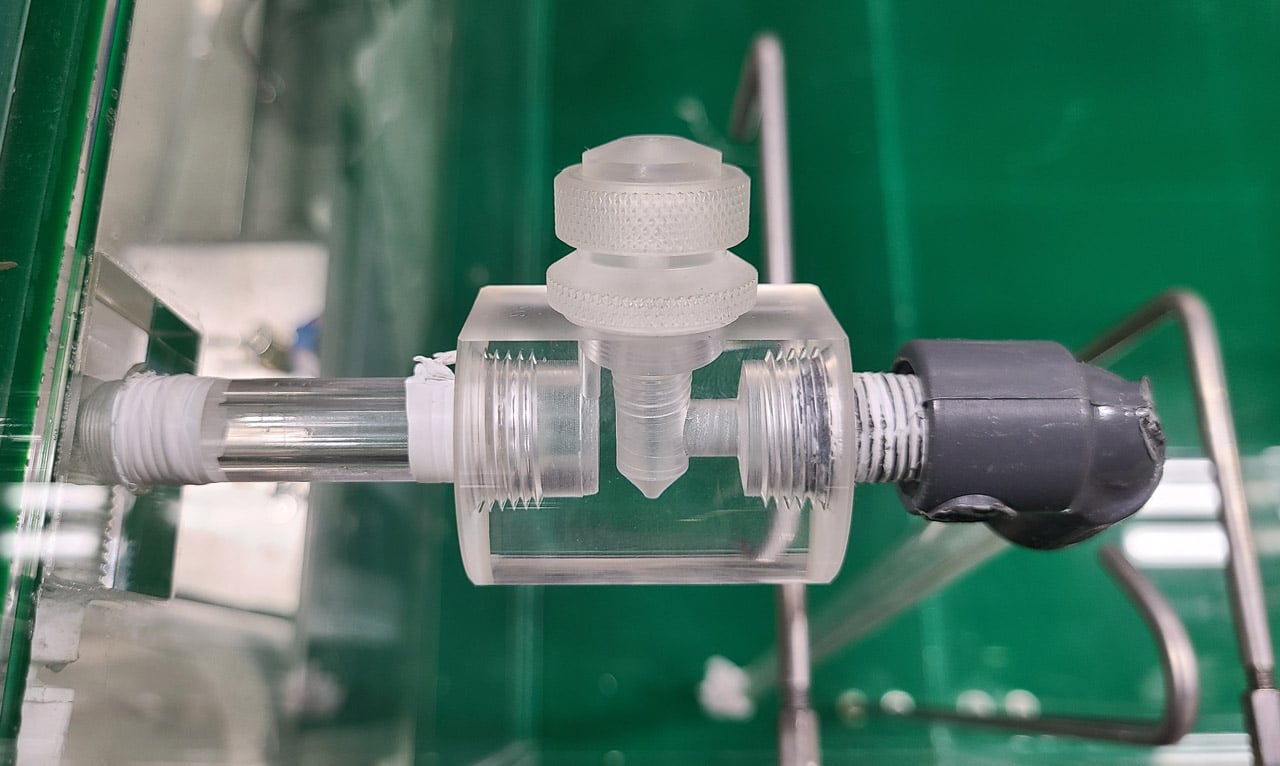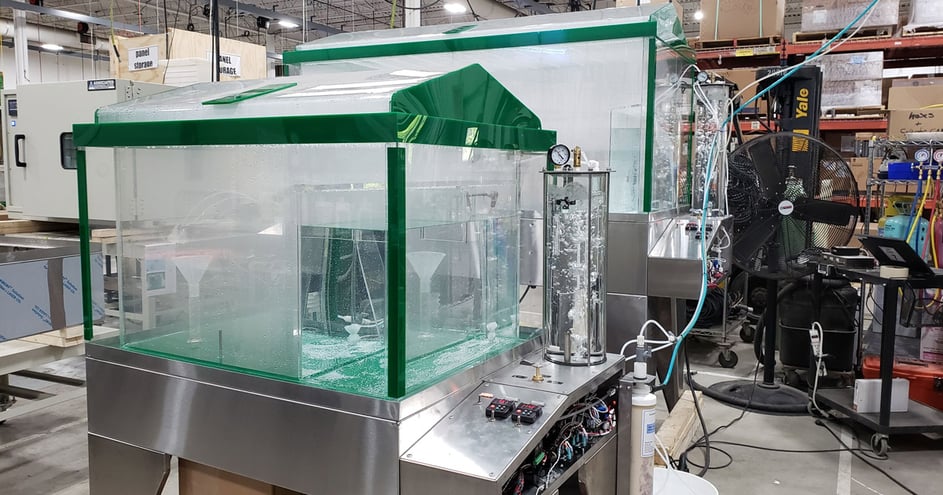Salt Spray Chamber Installation, Setup, and Operating Procedures
You finally have your salt spray chamber, and you’re anxious to test out products to accurately ensure they’re corrosion resistant before they go to market.
Here’s a review to guarantee you not only set up and install it correctly but also operate it properly every time.
Installing & Setting Up a Salt Spray Chamber
Unpacking Your Salt Chamber
Exercise caution when opening the packaging. While the clear sheeting typically used in salt spray chambers constructed from lucite is rather durable, shipping can be rough enough to cause damage. Be sure to examine your salt spray chamber for cracks that may have occurred during shipping. Reach out to your manufacturer immediately if you identify a fracture or a chip in the lucite. Much like with a car windshield, over time a crack can expand.
Find a hard, level surface with abundant ventilation to become the resting place for your salt spray chamber. You want there to be plenty of space around the chamber in a room with significant ventilation. (See below for more on ventilation.)
Power and Utility Requirements
The electric panels and chamber come already completely wired and ready for use. Keep in mind the power source, in most cases, must be grounded.
You’ll also need a reliable water source. Notably, salt spray chambers require distilled (demineralized) water. You’ll always want to feed untreated tap water through a demineralizer cartridge before employing it in your chamber.
While the amount of water a chamber consumes varies per model, here’s a little formula to help determine the capacity of a demineralizer cartridge: 1600 grains TDS/17.12 ppm=capacity in gallons. That cartridge should be changed when three-quarters of the pellets have changed to their used color.
Salt Spray Nozzle Assembly

Salt spray chambers come equipped with an atomizing nozzle, but should you need to replace it, you’ll likely need to take the following steps:
- Apply a quarter-inch wide strip of Teflon tape to all joints. Avoid letting the tape enter the inside of the pipe. It’s best to apply tape at least two to three threads away from the end of the pipe.
- While preventing any foreign objects from entering the pipe, screw the acrylic quarter-inch pipe nipple into the taped hole on the inside of the chamber. You should be able to easily tighten it by hand.
- Once tightened by hand, adjust the nozzle so the spray is oriented toward the front of the chamber while the other taped hole in the nozzle points downward.
- Tighten the long acrylic quarter-inch threaded pipe into the taped hole at the bottom of the nozzle until it is snug. (This pipe is referred to as the siphon tube.)
- Place the nylon mesh strainer over the other end of the siphon tube and hold it in place with rubber bands. If a special MIL-STD-202 or MIL-STD-810 filter is used, attach it to the end of the siphon tube.
- Place the salt reservoir cover on the top of the salt reservoir and you're done.
Salt Spray Chamber Ventilation
To prevent back pressure within the chamber, it must be exhausted. When setting up the chamber, be sure to install a non-corrosive three-quarter-inch pipe from the exhaust chamber to a point outside the building. This exhaust should be as short as possible, straight, and gently sloping downward from the chamber to avoid any liquid traps. It should also be shielded from the effects of wind or air currents.
While a flexible hose can be an option, you must be diligent to ensure it doesn’t sag in sections, creating liquid traps. If the length of your exhaust extends beyond 10 feet, a two-inch line should be used. If your pipe absolutely must exit upward through the roof, use a T-fitting rather than an elbow. Align the T so an 18-inch drop line and drain can be added to ensure the exhaust line remains clear at all times.
Salt Chamber Air Supply
A salt spray chamber needs clean, oil-free compressed air, and has already been furnished with the valve marked “air” at the rear end of the chamber. It is common for compressed air flow SCFM to range from 1.5/0.71 (liters/sec) to 4.0/1.89. The pressure PSIG will operate between 6-10, depending on the model.
Your salt spray chamber should now be all set up. Read on to learn more about how to operate it.
Operating Your Salt Spray Chamber
First, here are a few more things to know regarding the construction of a typical salt spray chamber.
Test Chamber Construction
Salt spray chambers are built with double-wall construction arranged to provide warm air circulation between the inner and outer walls. Blowers and heaters located in the base circulate warm air in a closed loop.
A thermostat is located within the testing area of the chamber, set at the factory to keep the temperature at 95 degrees Fahrenheit plus or minus two degrees.
The salt atmosphere is generated via the atomizing nozzle, which uses compressed air to siphon the salt solution from the reservoir. The compressed air is first warmed and saturated by bubbling it through heated water stored in the saturation tower. The heater located inside the tower is controlled by a thermostat that is factory set to maintain a tower temperature of 114 degrees Fahrenheit (45.5 degrees Celsius).
By saturating the air at a temperature higher than the air temperature near the salt spray nozzle, a small amount of condensing moisture continuously purges the nozzle, reducing the tendency for the salt solution to crystallize and clog. This assures consistent conditions at the nozzle, providing a uniform atmosphere inside the test chamber.
The salt solution should be prepared in accordance with whatever test specifications you are trying to meet. Many standards require a 20 percent salt solution, which would translate to two pounds one ounce of sodium chloride per gallon of distilled or demineralized water.
The thermostat located in the testing area of the chamber controls the temperature inside, keeping it at 95 degrees Fahrenheit plus or minus two degrees (35 degrees Celsius). The thermostat also controls an air heater mounted to the blower. This thermostat has been factory set and should not require any adjustment.
If it is necessary to change the temperature, the thermostat can be modified by turning the adjustment screw. Clockwise rotation of the screw decreases the temperature. Adjustments should be in increments of no more than an eighth turn. Be sure to budget adequate time for stabilization before making additional adjustments.
Start-up Procedure
You should follow this sequence of operation at the beginning of every test:
- Make sure the chamber is positioned on a level surface.
- Connect the vent line ensuring it is free of restrictions.
- Fill the tower reservoir.
- Fill the salt reservoir to within one inch of the top and replace the cover.
- The temperature of the solution should be at 95 degrees Fahrenheit or lower when filling the reservoir.
- Fill the top cover trough and close it.
- The top cover of the chamber has a water seal to prevent salt fog from entering the room.
- Fill this trough periodically with distilled or demineralized water.
- It is important that the chamber be properly leveled in order to provide a satisfactory seal.
- Connect the chamber compressed air supply.
- Now is a good time to double-check that the air is supplied at the correct pressure.
- Open the chamber air valve.
- Turn the compressed air supply on.
- With the selector valve in the salt spray position, place the tower switch in the on position.
- Place the circulation and chamber switches in the on position and check the following:
- Air should bubble up through the saturation tower.
- A fine mist should emerge from the atomizing nozzle.
- There should be air flowing through the exhaust line.
- There should not be any air bubbling through the water seal around the cover.
- After the chamber temperature has stabilized (approximately 30 minutes after the chamber pilot light first starts to cycle on and off) check the chamber and tower temperatures.
- Observe the temperature of all heated areas making sure the maximum temperature stated in the manual is not exceeded.
- Check the proper action of the thermostats by observing the electric panel pilot lights.
- These lights should cycle when various temperatures are near their setpoint values.
- Check for proper operation of the salt spray nozzle.
- The chamber is now ready for use!
At the end of the test, place the selector switch in the purge position. Ensure the air is being admitted directly to the chamber and flowing freely from the exhaust. That’s roughly all you need to know to install, set up, and operate your new salt spray test chamber.
Should you have any questions, you can contact Associated Environmental Systems. AES offers help with onsite repairs and maintenance and is always willing to further talk you through installation, setup, and operation of your salt spray test chamber.



